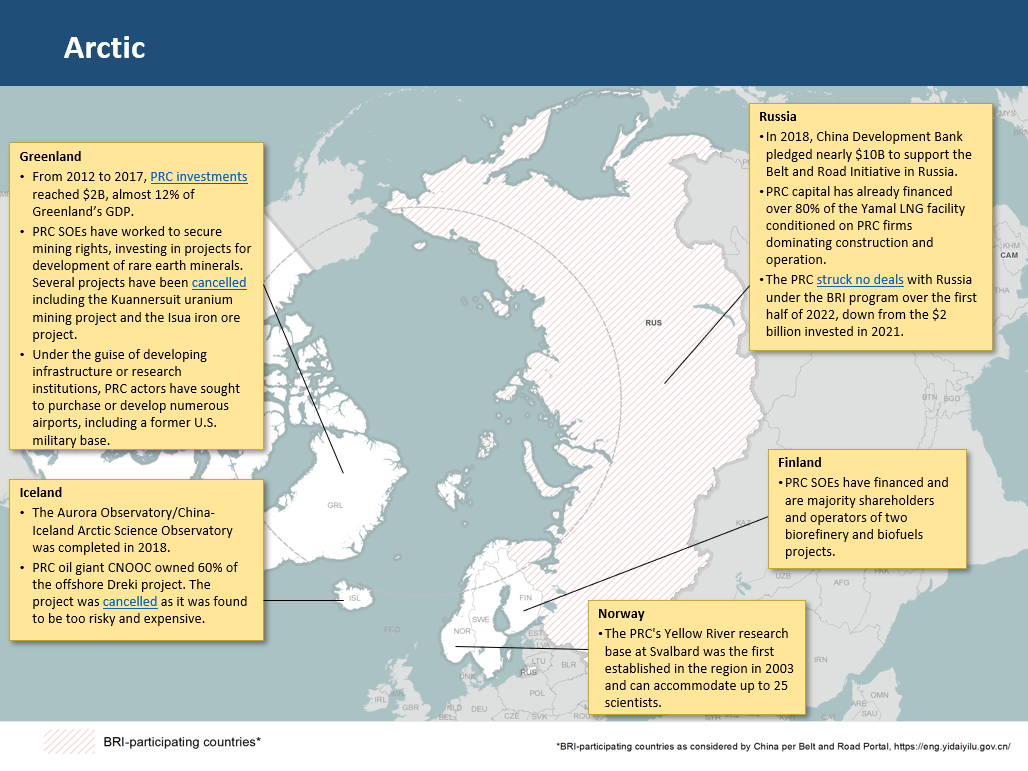
China’s Influence in the Arctic:
The PRC’s first major play in the Arctic was in 2003, when their first research base was established in Svalbard, Norway. Since then, the PRC has utilized seemingly altruistic motives like research activities and infrastructure development to gain access and influence in the region.
The PRC has invested over $90 billion above the Arctic Circle in infrastructure, assets, or other projects. Investments are largely in the energy and minerals sectors.
In 2013, Iceland was the first European state to sign a free trade agreement with the PRC. On the same day, the Icelandic government announced its support for the PRC’s ascension as a member of the Arctic Council. Shortly after, China was approved for observer status on the Arctic Council.
The PRC published an Arctic Strategy in 2018, which outlined plans to develop a Polar Silk Road and created the title of “near-Arctic state”, a classification which does not exist and is not universally recognized. This strategy, the “near-Arctic state” title, and the increasing investment in Arctic infrastructure are aimed to give the PRC more standing in its claim as an Arctic stakeholder.
China’s Foreign Investment in the Arctic:
Several Arctic countries have very minimal review processes in place to evaluate sources of Federal Direct Investment (FDI). Greenland and Iceland have the highest percentages of PRC investment in the Arctic. As of 2017, these investments made up nearly 12% of Greenland’s GDP and 6% of Iceland’s GDP.
- To address this issue, in 2022, Iceland passed legislation taking into consideration national security concerns regarding its telecommunications networks.
The PRC views the Northern Sea Route as a key area for investment. In 2017, President Xi stated that cooperation between China and Russia would help create a “Ice Silk Road”. In 2018, the China Development Bank pledged nearly $10 billion to support the Belt and Road Initiative in Russia with a particular focus on developing the Arctic and Northern Sea Route. Several PRC SOEs (state-owned enterprise) have invested in large scale infrastructure projects in Russia and the Nordic region. PRC SOEs have also made several failed attempts to purchase critical infrastructure in Greenland, including three airports and a former U.S. military base – these were diverted or rejected by the Danish government.
In 2011, a PRC-based businessman sought to purchase land in Iceland to develop a golf resort – this offer was ultimately rejected in part because of fears that an airfield or deep-sea port would be developed instead.
China’s Foreign Investment in the Arctic Mining and Energy Sectors:
The Kvanefjeld uranium project in Greenland is valued at $1.4 billion – Shenghe Resources, a CCP SOE, owns 12.5% of the project.
- However, this project has stalled due to environmental reasons, as Greenland passed The Uranium Act (Act No. 20), which “bans all prospecting, exploration, and exploitation of uranium.”
In Greenland, two CCP SOEs, CNOOC and CNPC, expressed interest in onshore energy licenses made available in 2021. However, Greenland has since halted issuance of onshore energy licenses, citing climate change as the main concern.
- CNOOC already owns a 60% share in two potential oil and gas shelf sites in Iceland – Dreki and Gammur.
In 2016, Sunshine Kaidi New Energy Group invested $1.13 billion for a new biodiesel plant in Finland.
- The Chinese Development Bank signed a financing agreement in 2017 for a biorefinery where CCP SOEs will be majority shareholders and operators.
In 2019, two CCP affiliated companies (CNOOC and CNPC) acquired a 20% stake in a Novatek natural gas megaproject, located in the Yamal Peninsula, Russia. Additionally, CNPC has a 20% stake in another Novatek LNG facility within Yamal.
In December 2020, the PRC mining company attempted to purchase a Canadian Arctic gold mine operated by TMAC Resources Inc. The agreement was blocked by the Canadian government over Arctic security concerns. The site of the mine is located 100 kilometers from a NORAD North Warning System radar station.
China’s Foreign Investment in Space and Data:
The first CCP overseas satellite-receiving ground station was established in Kiruna, Sweden in 2016. In 2018, the PRC and Finland agreed to establish a joint center for satellite observation and remote sensing.
Before Greenland had even authorized it, a CCP delegation celebrated the future construction of a satellite ground station at the Kangerlussuaq airport in 2017.
CCP SOE’s, like Huawei Marine, are partnering with artic nations, such as Finland and Greenland, to build undersea communications cables along the Northern Sea route. The PRC is currently reliant on foreign cables for all data transfer between Asia and Europe – a Huawei cable would shield CCP data transfers from others.
- Such cables increase the CCP’s underwater surveillance capabilities and significantly enhance its eyes and ears in the strategic Arctic region.
China’s “Soft Power” in the Arctic:
Russia and the CCP established the Sino-Russian Arctic Research Center in 2019, which was intended to be utilized in 2020 for a joint expedition to research routes through the Northern Sea Route and climate change. The PRC was set to cover 75% of the cost of the expedition. However, this mission has been delayed, likely due to Covid-19.
The University of Iceland hosts the Northern Light Confucius Institute.
- The China-Iceland Arctic Science Observatory was also completed in 2018 on land leased to the Polar Research Institute of China.
The CCP’s eye has also turned toward tourism development above the Arctic Circle as a means to snap up real estate.
- CCP SOEs are developing a hotel at the Arctic Circle in Rovaniemi, Finland and another is planned for nearby Saariselka.
Greenland also sent a permanent representative to Beijing for trade purposes in July 2018.
In February 2022, Russia and China released a joint statement committing to intensify “practical cooperation for the sustainable development of the Arctic”.
*Last updated: 10/25/2022
###